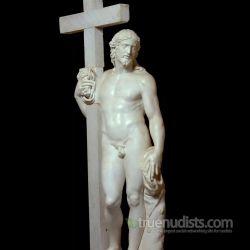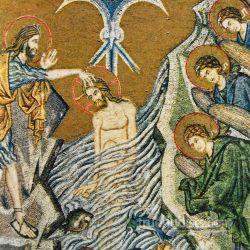Nudity In The Bible
This is a group for those who are looking for, or wish to share stories and verses, in the Christian Bible, about nudity.
Jesus Died Naked....
Return to Discussions~How Rome Crucified Criminals and How Jesus Suffered~
~May be to much for your stomach~
The ancient Romans executed enemies and criminals in a number of gruesome ways. The most well known form of Roman execution was crucifixion. In Roman times men were supposed to die with honor, bravely, and preferably in battle or at least fighting, with their heads held high even as they were speared or beheaded or even hanged. But men being crucified almost never died with honor. In fact, some didn't even die as men. There is historical evidence that indicates that most men that were executed on the cross were stripped naked, and were exposed to large crowds and were invariably crucified at a spot where they were sure to be widely seen. In fact, naked crucifixions were the norm.
Of course, humiliation and a degrading death were part of the method.It was a death to be feared, and it was considered so demeaning and so humiliating that in ancient Rome it was forbidden to crucify a citizen. No Roman citizen could be crucified, under any circumstance, or for any reason, regardless of what his crime was. That alone indicates how heinous a death it was considered to be.
The crosses used for execution were usually in two pieces, although sometimes individuals were crucified on trees, and there were enough variations that it is hard to be specific about a particular norm.
Usually, the crosses were in two parts. The vertical posts, called "stipes" were usually permanently mounted into the ground, Contrary to many artists portrayals, usually these posts were not very tall, because as long as the man being crucified couldn't touch the ground with his feet then the lower he was the easier people could taunt him and watch his misery.
The man being executed was often made to carry the heavy cross piece, usually on his back, with his two wrists tied out along the beam, so that he couldn't put it down or drop it.
He was then made to walk, almost certainly naked, through the town or city, to his place of execution. If he stopped or faltered then he was beaten or whipped to keep him going.
This cross piece was called the "patibulum" and it could be mounted to the vertical post either at the very top, forming a "T" shaped cross, or into a grove, in what we today would think of as a more classic cross. Other cross designs were used however, and some men were even crucified to trees when it was more convenient to do so.
The Romans used various methods to affix the condemned man to the cross. Certainly, many were probably just tied in place, their wrists bound to the patibulum and their ankles similarly tied to the stipe.
However, for the worst offenders, crude nails were used. These metal spikes were an especially cruel method and perhaps that's why the Romans favoured them.
The only recovered skeleton of a man that was actually crucified still has a crucifixion spike driven through its right ankle, with its leg bones broken. The recovered artefact also shows a smaller flat piece of wood under the head of the nail, invariable to insure that the man couldn't pull his tissue through to free himself, regardless of how hard he struggled.
Without question though, many were nailed to cross, with the spike going between the two major long bones of the arm right where they attach to the wrist.
Some men were only secured by their wrists, and they were just allowed to hang from their arms until they expired. However, the death process would occur much faster when that method was used, and since this usually wasnt desired almost always the feet were also attached to the upright post. This would stretch out the execution, and prolong the man's suffering immensely.
Normally the feet were also nailed to the upright post.
There are several methods that appear to have been used. Based on the archaeological finds, two nails were at least sometimes used, one for each foot, and the man's legs were nailed to the sides of the upright beam, with one spike driven sideways straight through each one of his heels.
The only recovered skeleton of a crucified man was nailed in this manner, as there is a six inch spike still embedded in one heel bone and part of the wood cross is still attached.
Another method appears to have been to use a single, longer nail, and then driving it straight through one foot that was placed and held on top of the other. That long nail was then driven straight down through the top of the feet and into the upright post underneath.
The amount of flex that was allowed in the legs was all important, and was the single most important item that would determine the length of suffering the condemned would have.
If the legs were bent in such a manner that victim could fully straighten them, locking his knees, then he could stand and take the weight off of the wrists more easily, alleviating much of the suffering that would otherwise be caused.
However, if the legs were nailed with a twist, or the feet were bent downward with the toes pointing at the ground, then it would prevent the man from rising up to the point he could lock his knees.
The victim could still lift himself, but only with his muscles, and he would have to strain to hold himself upward to take the pressure from his arms and the nerves punctured by the nails.
Of course, that was desired, and research indicates that the Romans usually did it that way. By pointing the toes downward and nailing the man's feet through the top and then through the arches, attaching them securely to the post, it would be impossible for the crucified man to lock his knees.
The same thing could be accomplished by folding his legs slightly backwards, with bent knees, before nailing them individually at the ankles. Either way would ensure a long torturous death.
Of course, hanging from these nails, and onto his median nerve, would be an indescribable torment that would have no end. The more weight the man put on his wrists, the more pain he endured. Hoisted up, and hanging that way, the condemned was now "crucified."
After that, his dance of death would commence, to the delight of those watching, and it would go on and on for many hours, and for some, even days. As the victim would sag down, and put more weight on the nails in his wrists, the pain would become unbearable, and he would push himself upward, by placing his weight on the nail or nails that have been driven through his feet.
So, up and down the victim would move. Up and down, dancing the death dance that all crucified men danced. They did not hang quietly, and they did not stay still. In fact, there is some indicators that when they were first placed on their cross most men struggled fiercely, jerking and thrashing as they fought to find some position to alleviate the terrible pain that consumed them.
Of course, there was no position at all that offered relief, but they would thrash and jerk and try to find it anyway. The pain was too much to comprehend, and while they had the strength the screams would come as they jerked and fought with every muscle. And of course, being naked, they would make quite a spectacle.
The mechanism of death that occurs during crucifixion is slow in coming, but it is relentless and in the end it is always lethal. leaving him in deep, driving pain, that has no bounds and with no relief in sight.
If there was a need to have the man dead by a certain deadline, or because of an upcoming religious holiday, then breaking the man's legs was a sure way to make it happen. Of course, that wasn't normally desired, and the longer the criminal suffered and more miserable his death was for those watching, the better was the deterrent value.
There was one final variable that the Romans added, and it was called the "sedile."
Sediles were not used on all crucified criminals, but they were definitely used and their use is documented in some sources.
The sedile was a seat of sorts, that allowed the condemned man to take some of the weight off of his shoulders and arms, which drew out the death process and prolonged his suffering. Using a sedile could more than double the time it would take for the man to die.
Probably the most common sedile was a simple rod, or plank, that jutted straight out of the upright post and went between his legs. It wasnt supposed to be comfortable. The condemned man could sit down on it, to a degree, sharing the load on the nailed feet. Certainly, it would crush his genitals as he did so, but that only added to his humiliation.
To increase the suffering of the condemned, sometimes the sedile was made out of a flat piece of wood, that had been sharpened to a fine edge and there is some evidence that some sediles were even made of a triangular shaped piece of iron. We can only imagine the pain and the damage that would have been caused if a man collapsed downward onto such a seat, slamming his naked genitals into the sharpened piece of wood or metallic bar that was jutting out between his legs and it is quite possible that a few prisoners crucified in that matter probably slowly castrated themselves as they struggled.
There is no documentation to support that however, although there is documentation on a different type of sedile, that was definitely used when it was deemed important to increase the humiliation of the man being crucified.
When that was desired, a different, more sinister and certainly more humiliating type of sedile was used.
Instead of a plank or post that went between the legs, a fairly stout rod, with a large bulbous end, was used, made of wood or metal, that was positioned into the condemned man's rectum so that he was seated onto it, and it inside of him.
This type of sedile carried a greater portion of his weight, which would significantly prolong his suffering.
It was also totally humiliating for a man to be impaled on such a seat, and there is little doubt that sexually it was stimulating, creating an even greater and more demeaning death for the condemned.
When his arms became so fatigued that he allowed himself to relax and fall downward, the sedile rod would go deep in his anus, literally buggering him in a very real and embarrassing way.
As it pushed deep inside of him, taking his weight, it would literally push all the way into his prostate. Of course, hanging down that far, the pain would then shoot through his wrists, and he would feel the need to use his thigh muscles and his arms and pull himself upward, lifting himself and in so doing pulling the rod upward within his rectum. Up and down he would struggle, all the time moving himself up and down over the rod in his anus. It would be impaling him, and in a way it would be almost like it was moving too, up and down inside of him, literally raping him.
For the man being crucified in front of men and women and children, this had to be without doubt the most demeaning and most humiliating punishment possible.
And, as a result of buggering himself on the sedile, the criminal almost invariable had an erection, and there are some historic paintings where there are erections on men being crucified.
One can only speculate how many times a crucified slave might ejaculate in front of the crowd, as he jerked and twisted and struggled up and down on the sedile.
If the crucified man had committed a sexual offence, then once he had ejaculated a number of times, the executioners would often castrate the man usually removing his penis first, and then his testicles.
The testicles would be hung round the dying man's neck on a cord, and the penis, often still in a state of erection, would be inserted into his mouth.
A small sign was almost always placed above the man so that anyone seeing him would know what he had done and see the consequences of his actions.
A crucified man's death is slow in coming, creeping upon him, making him feel every bit of misery and pain and humiliation right up to the very end.
Finally, his muscles can take no more, and he rises up less and less. He can't breath, but tries to anyway, struggling and gasping and in a panic as his heart races and he feels himself suffocating. His muscles ripple and quiver as he tries to find the strength to lift himself and to take another breath. Fluid may begin to fill his lungs. He knows its happening too, and he fights it, fights it but there is nothing left within him to fight it with. So, with open eyes and the agony of a man who cannot breathe and who has no muscles left to lift himself again, slowly death comes to him.
- 5 years ago
Growing up, we always saw Jesus in a loincloth but it was pretty much understood that he was completely naked. A lot of people feel like we should at least give him some dignity even if the people who crucified him didn't.
- 4 years ago
Some people believe that Jewish men were crucified with a small loincloth, not for their sake but so that the people passing by would not have to see a circumcised penis, which was offensive to Greeks and Romans.
- 2 years ago
Yup. It wasnt such earthshattering breaking news back in the day; but after decades of brainwashing, Young myopic navel gazing Christians & Others probably can ONLY reckon that Christ was Cruxified in Full Roman Senatorial Attire which no self respecting Jew, Peasant, much less the Son of God, would aim to imitate or emulate.
It would make even less sense to be Baptised Fully Clothed & soak Ones ONLY set of attire, since Christ indicated that His Followers should own, at most. one set of clothes.
#SaintMattX9: Do not acquire gold, or silver, or copper for your money belts, or a bag for your journey, or even two coats, or sandals, or a staff; for the worker is worthy of his support.
- a year ago
Have You ever had an Erection ( much less Ejaculated ) while enduring any sort of unrelated discomfort or pain. Even those Men who enjoy being Paddled or Whipped rarely if ever get Erect. But I am always open to viewing Evidence.
Got any footnotes, citations, sources or scientific photos for the Research & Evidence & Assertions You referenced? I am Literate but more of a visual learner.
- a year ago





